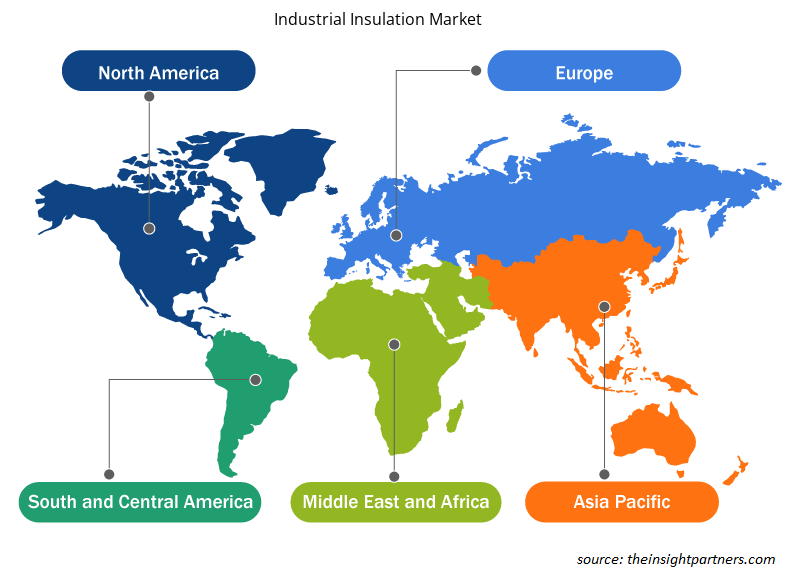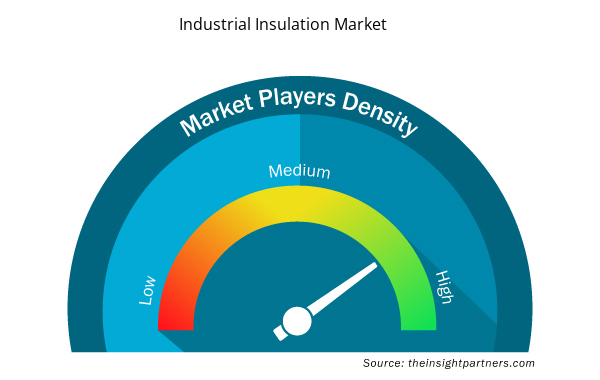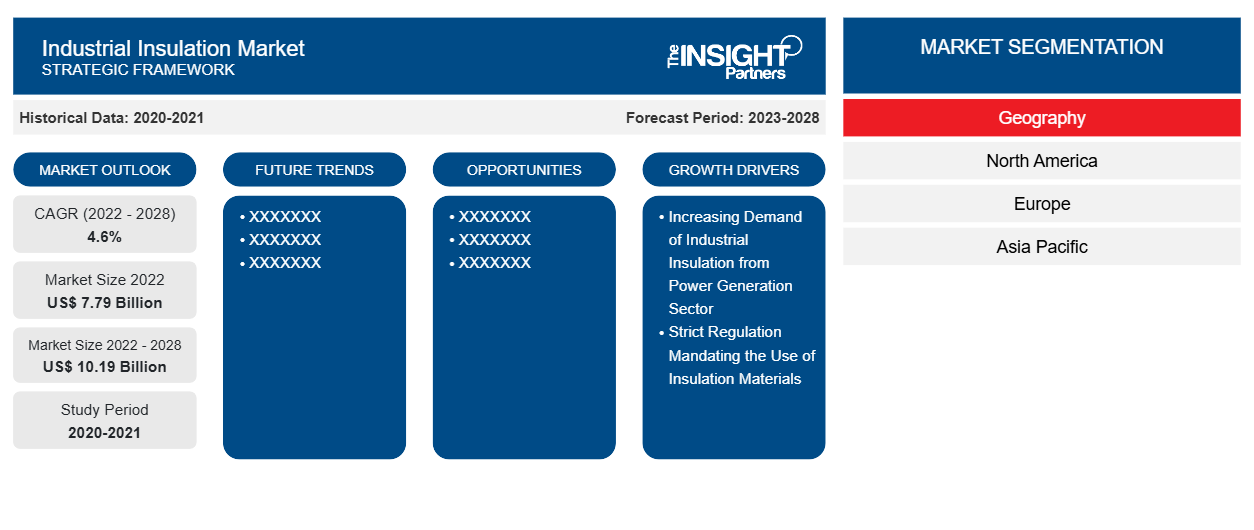[調査レポート] 産業用断熱材市場は、2022年の77億9,391万米ドルから2028年には101億8,911万米ドルに成長すると予想されており、 2022年から2028年にかけて4.6%のCAGRで成長すると予想されています。
市場分析
工業用断熱材は、発電、化学および石油化学、セメント、食品および飲料など、さまざまな業界で重要な役割を果たしています。工業用断熱材は、蒸気発生ボイラーの温度レベル維持に役立つため、さまざまな水力発電所で非常に重要です。さらに、新興経済国でのインフラ支出の増加は、予測期間中に市場の成長に有利な機会を提供すると予想されています。世界中のさまざまな国で建設活動が増加しているため、工業用断熱材の需要が高まっています。インフラストラクチャでの工業用断熱材の使用は、熱、火災、腐食からの保護に役立ちます。
成長の原動力と課題
世界中で省エネのために断熱材の使用を義務付ける厳格な規制が、工業用断熱材の市場成長を後押ししています。断熱材は熱の流れに抵抗し、暖房や冷房のコストを下げるのにも役立ちます。省エネ目的で断熱材の使用を義務付ける厳格な規制は、工業用断熱材市場の成長を後押しする主な要因です。省エネ規制と、石油・ガス、化学・石油化学、食品・飲料などの最終用途産業における断熱材の必要性が、市場の成長を牽引しています。米国機械学会 ( ASME )、米国ボイラー製造者協会 ( ABMA )、米国材料試験協会 ( ASTM ) など、さまざまな協会によって確立された規格が、業界の機器の設計に適用され、安全プロトコルを実装することで、工業用断熱材市場の成長を後押ししています。工業用断熱材の設置コストが高いことが、工業用断熱材市場の課題となっています。工業用断熱材の設置コストは、タイプ、設計、サイズ、複雑さによって異なります。工業用断熱材の設置は複雑なプロセスであり、高度なツールと操作が必要です。さらに、施設のサイズ、断熱面積、断熱材を評価するために、技術的に訓練された人が必要です。さらに、ミネラルウール、フォームボード、グラスファイバーなどの重い断熱材の設置には資格のある専門家が必要であり、産業用設置コストが追加されます。
要件に合わせてレポートをカスタマイズする
このレポートの一部、国レベルの分析、Excelデータパックなど、あらゆるレポートを無料でカスタマイズできます。また、スタートアップや大学向けのお得なオファーや割引もご利用いただけます。
- このレポートの主要な市場動向を入手してください。この無料サンプルには、市場動向から見積もりや予測に至るまでのデータ分析が含まれます。
レポートのセグメンテーションと範囲
「2030 年までの世界の工業用断熱材市場分析」は、世界の市場動向と成長機会に重点を置いた専門的で詳細な調査です。このレポートは、原材料、製品、エンドユーザー、および地域別の詳細な市場区分とともに、世界市場の概要を提供することを目的としています。世界の工業用断熱材市場は、ここ最近、高い成長を遂げており、予測期間中もこの傾向が続くと予想されています。このレポートでは、世界の工業用断熱材の消費量と、主要地域および国における需要に関する主要な統計を提供しています。さらに、このレポートでは、主要地域および国における工業用断熱材市場のパフォーマンスに影響を与えるさまざまな要因の定性的な評価も提供しています。このレポートには、工業用断熱材市場の主要プレーヤーとその主要な戦略的展開に関する包括的な分析も含まれています。また、主要な推進要因、市場動向、および収益性の高い機会を特定するために役立つ、市場ダイナミクスに関するいくつかの分析も含まれています。
さらに、エコシステム分析とポーターの 5 つの力の分析により、世界の産業用断熱材市場の 360 度の視点が得られ、サプライ チェーン全体と市場の成長に影響を与えるさまざまな要因を理解するのに役立ちます。
セグメント分析
世界の工業用断熱材市場は、原材料、製品、およびエンドユーザーに基づいてセグメント化されています。原材料に基づいて、工業用断熱材市場はウール、フォーム、繊維、その他に分類されます。製品に基づいて、市場はパイプ、ボード、毛布、その他に分類されます。工業用断熱材市場は、エンドユーザーに基づいて、発電、化学および石油化学、セメント、食品および飲料、その他に分類されます。原材料に基づいて、フォーム原材料が大きなシェアを占めました。グラスファイバーの形のウール断熱材は、ガラスを高温で加熱して溶かし、溶融ガラスをすばやくねじって繊維を作ります。次に、グラスウール繊維を結合して断熱材として使用します。空気は熱伝導率が低いため、ガラス繊維は熱損失の障壁として機能する空気ポケットを作成します。フォーム断熱材は、断熱、防音、耐候性など、さまざまな防水および断熱エンドユーザーに広く使用されているポリマー製品です。繊維には、天然繊維、合成繊維、またはプラスチック繊維が含まれます。セラミック繊維とリサイクルされたペットボトル(PET で構成)は、主に工業用断熱材のエンドユーザー向けの製品であり、形成された繊維は圧縮されて断熱材になります。製品別では、パイプセグメントが大きなシェアを占めています。グラスファイバーは、コストが低く設置が簡単なため、商業、工業、公共施設の鉄、銅、PVC パイプの断熱に広く使用されています。工業用断熱ボードは、空洞壁の断熱によく使用されます。ブランケット断熱材は、主に高温のセットアップで使用され、動作温度は最大 1150°C です。ブランケット断熱材の一般的なエンドユーザーには、熱交換器、スタック設備、冷却塔、空調ダクト、大口径配管、貯蔵タンクなどがあります。その他の製品には、スプレーフォーム断熱材や断熱コンクリートがあります。スプレーフォーム断熱材は、床、壁、天井の空洞を空気の流れから密閉する空気バリアおよび断熱材です。発電は工業用断熱材の主要市場です。適切な機器断熱は、発電所のメンテナンスに役立ち、作業員の怪我や火傷のリスクを軽減します。化学処理では、生産品質の一貫性と信頼性を保つために、安定した温度が必要です。化学および石油化学業界の成長により、工業用断熱製品の需要が高まると予想されています。セメント製造は、生産量を最適化するために高度な熱ソリューションを必要とする連続プロセス産業です。その他セグメントは、自動車、航空宇宙、ガラス製造などにさらに細分化されています。工業用断熱ソリューションは、車両コンポーネントとその電気配線を保護するために使用されます。
地域分析
このレポートは、北米、ヨーロッパ、アジア太平洋(APAC)、中東およびアフリカ(MEA)、中南米の5つの主要地域に関して、世界の産業用断熱材市場の詳細な概要を示しています。アジア太平洋地域は市場の大きなシェアを占め、2022年には40億米ドル以上の価値があるとされています。アジア太平洋地域のほとんどの国では、電力需要の継続的な増加が見込まれており、予測期間中にこの地域の産業用断熱材製品の需要が高まると予想されています。北米でも、建設業界で高まる非腐食性減水剤の需要を満たすためにリグニンスルホン酸ベースのコンクリート混和剤を必要とする最終用途産業による拡張戦略の採用が増えているため、2028年には約16億米ドルに相当する大幅な成長が見込まれています。ヨーロッパは4.0%を超えるCAGRで大幅に成長しています。さまざまな国における化学製造拠点や航空宇宙産業の強力な存在が、ヨーロッパの産業用断熱材市場を支えています。
業界の発展と将来の機会
このレポートでは、北米、ヨーロッパ、アジア太平洋 (APAC)、中東およびアフリカ (MEA)、南米および中米の 5 つの主要地域に関する世界の産業用断熱材市場の詳細な概要を示します。
2022年、サンゴバンはフランスで新たなグラスウール生産能力に1億2000万ユーロを投資する計画です。この投資はフランスでの断熱材生産能力の増強を目的としており、既存のISOVER生産ラインの増産と新ラインの建設が含まれます。
2020年、ジョンズ・マンビルは、工業用断熱材市場向けの撥水ミネラルウール製品の完全なポートフォリオの発売を発表しました。この製品の発売は、工業用断熱材市場における撥水材の需要の高まりに対応することを目的としていました。
COVIDの影響/地政学的シナリオの影響/景気後退の影響
このレポートは、北米、ヨーロッパ、アジア太平洋(APAC)、中東およびアフリカ(MEA)、中南米の5つの主要地域に関して、世界の工業用断熱材市場の詳細な概要を示しています。建設、化学および石油化学、食品および飲料などの業界は、工業用断熱材の主な消費者です。2020年、これらの業界は、国境および国境の閉鎖によって引き起こされたバリューチェーンの混乱により、業務を減速せざるを得ませんでした。さらに、さまざまな国が課したロックダウンにより、同じ年に業界が在庫レベルを維持する能力が妨げられました。パンデミックは、化学業界と建設業界にも大混乱をもたらしました。人手不足により、工業用断熱材の生産と流通業務が減速しました。さらに、政府の規制やその他のCOVID-19予防措置により、バリューチェーン内の工業用断熱材メーカーの生産能力が低下しました。2021年、さまざまな国の政府が社会的制限の緩和を発表したため、世界市場は2020年に発生した損失から回復し始めました。さらに、世界各地の化学・材料産業の生産能力が拡大したことにより、2021年には産業用断熱材の需要が増加しました。
産業用断熱材市場の地域別分析
予測期間を通じて産業用断熱材市場に影響を与える地域的な傾向と要因は、Insight Partners のアナリストによって徹底的に説明されています。このセクションでは、北米、ヨーロッパ、アジア太平洋、中東、アフリカ、南米、中米にわたる産業用断熱材市場のセグメントと地理についても説明します。

- 産業用断熱材市場の地域別データを入手
産業用断熱材市場レポートの範囲
| レポート属性 | 詳細 |
|---|---|
| 2022年の市場規模 | 77億9000万米ドル |
| 2028年までの市場規模 | 101億9000万米ドル |
| 世界のCAGR(2022年 - 2028年) | 4.6% |
| 履歴データ | 2020-2021 |
| 予測期間 | 2023-2028 |
| 対象地域と国 | 北米
|
| 市場リーダーと主要企業プロフィール |
|
市場プレーヤーの密度:ビジネスダイナミクスへの影響を理解する
工業用断熱材市場は、消費者の嗜好の変化、技術の進歩、製品の利点に対する認識の高まりなどの要因により、エンドユーザーの需要が高まり、急速に成長しています。需要が高まるにつれて、企業は提供品を拡大し、消費者のニーズを満たすために革新し、新たなトレンドを活用し、市場の成長をさらに促進しています。
市場プレーヤー密度とは、特定の市場または業界内で活動している企業または会社の分布を指します。これは、特定の市場スペースに、その規模または総市場価値と比較して、どれだけの競合相手 (市場プレーヤー) が存在するかを示します。
工業用断熱材市場で事業を展開している主要企業は次のとおりです。
- ニチアス株式会社
- アスペンエアロゲルズ株式会社
- マカリスターミルズ株式会社
- ロックウールA/S
- サンゴバンSA
免責事項:上記の企業は、特定の順序でランク付けされていません。

- 産業用断熱材市場のトップキープレーヤーの概要を入手
競争環境と主要企業
工業用断熱材市場で事業を展開している主要企業としては、ニチアス株式会社、Aspen Aerogels Inc、McAllister Mills Inc、Rockwool A/S、Saint Gobain SA、Knauf Insulation、Kingspan Group、Cabot Corporation、Johns Manville、Thomas Group などが挙げられます。
- 過去2年間の分析、基準年、CAGRによる予測(7年間)
- PEST分析とSWOT分析
- 市場規模価値/数量 - 世界、地域、国
- 業界と競争環境
- Excel データセット


- Real-Time Location Systems Market
- Single-Use Negative Pressure Wound Therapy Devices Market
- Quantitative Structure-Activity Relationship (QSAR) Market
- Queue Management System Market
- Wheat Protein Market
- GNSS Chip Market
- Smart Mining Market
- Environmental Consulting Service Market
- Batter and Breader Premixes Market
- Energy Recovery Ventilator Market

Report Coverage
Revenue forecast, Company Analysis, Industry landscape, Growth factors, and Trends

Segment Covered
This text is related
to segments covered.

Regional Scope
North America, Europe, Asia Pacific, Middle East & Africa, South & Central America

Country Scope
This text is related
to country scope.
よくある質問
The global industrial insulation market is primarily driven by increasing demand from power generation sector and strict regulation mandating the use of insulation materials for energy conservation.
Major players operating in the global industrial insulation market includes, Nichias Corporation, Aspen Aerogels Inc., McAllister Mills Inc., ROCKWOOL A/S, SAINT GOBAIN S.A., Knauf Insulation, Kingspan Group, CABOT CORPORATION, Johns Manville, and Thomas Group.
The pipe segment held the largest share of the global industrial insulation market in 2021. Pipe insulation helps to reduces energy losses to a great extent, hence reducing the energy cost. Cellular glass, one of the types of materials used in pipe insulation, is used in ductwork, heat transfer fluid systems, chemical processing systems, commercial pipework, storage tanks, and other application areas.
In 2021, Asia Pacific held the largest share of the global industrial insulation market. The industrial insulation market growth in the region is driven by increasing demand from various industries, including power generation, chemical & petrochemical, and food & beverage, the growing industrial activities, and strong economic growth in the region.
Asia Pacific is estimated to register the fastest CAGR in the global industrial insulation market over the forecast period. This is mainly attributed to an increasing use of industrial insulation materials in different application fields, increasing infrastructural spending, and strong economic growth.
The foams segment held the largest share of the global industrial insulation market in 2021. Foam insulations are commonly used for various proofing and insulation applications, including thermal insulation, acoustic insulation, and weatherproofing.
Trends and growth analysis reports related to Chemicals and Materials : READ MORE..
The List of Companies - Industrial Insulation Market
- Nichias Corporation
- Aspen Aerogels Inc.
- McAllister Mills Inc.
- ROCKWOOL A/S
- SAINT GOBAIN S.A.
- Knauf Insulation
- Kingspan Group
- CABOT CORPORATION
- Johns Manville
- Thomas Group
The Insight Partners performs research in 4 major stages: Data Collection & Secondary Research, Primary Research, Data Analysis and Data Triangulation & Final Review.
- Data Collection and Secondary Research:
As a market research and consulting firm operating from a decade, we have published and advised several client across the globe. First step for any study will start with an assessment of currently available data and insights from existing reports. Further, historical and current market information is collected from Investor Presentations, Annual Reports, SEC Filings, etc., and other information related to company’s performance and market positioning are gathered from Paid Databases (Factiva, Hoovers, and Reuters) and various other publications available in public domain.
Several associations trade associates, technical forums, institutes, societies and organization are accessed to gain technical as well as market related insights through their publications such as research papers, blogs and press releases related to the studies are referred to get cues about the market. Further, white papers, journals, magazines, and other news articles published in last 3 years are scrutinized and analyzed to understand the current market trends.
- Primary Research:
The primarily interview analysis comprise of data obtained from industry participants interview and answers to survey questions gathered by in-house primary team.
For primary research, interviews are conducted with industry experts/CEOs/Marketing Managers/VPs/Subject Matter Experts from both demand and supply side to get a 360-degree view of the market. The primary team conducts several interviews based on the complexity of the markets to understand the various market trends and dynamics which makes research more credible and precise.
A typical research interview fulfils the following functions:
- Provides first-hand information on the market size, market trends, growth trends, competitive landscape, and outlook
- Validates and strengthens in-house secondary research findings
- Develops the analysis team’s expertise and market understanding
Primary research involves email interactions and telephone interviews for each market, category, segment, and sub-segment across geographies. The participants who typically take part in such a process include, but are not limited to:
- Industry participants: VPs, business development managers, market intelligence managers and national sales managers
- Outside experts: Valuation experts, research analysts and key opinion leaders specializing in the electronics and semiconductor industry.
Below is the breakup of our primary respondents by company, designation, and region:

Once we receive the confirmation from primary research sources or primary respondents, we finalize the base year market estimation and forecast the data as per the macroeconomic and microeconomic factors assessed during data collection.
- Data Analysis:
Once data is validated through both secondary as well as primary respondents, we finalize the market estimations by hypothesis formulation and factor analysis at regional and country level.
- Macro-Economic Factor Analysis:
We analyse macroeconomic indicators such the gross domestic product (GDP), increase in the demand for goods and services across industries, technological advancement, regional economic growth, governmental policies, the influence of COVID-19, PEST analysis, and other aspects. This analysis aids in setting benchmarks for various nations/regions and approximating market splits. Additionally, the general trend of the aforementioned components aid in determining the market's development possibilities.
- Country Level Data:
Various factors that are especially aligned to the country are taken into account to determine the market size for a certain area and country, including the presence of vendors, such as headquarters and offices, the country's GDP, demand patterns, and industry growth. To comprehend the market dynamics for the nation, a number of growth variables, inhibitors, application areas, and current market trends are researched. The aforementioned elements aid in determining the country's overall market's growth potential.
- Company Profile:
The “Table of Contents” is formulated by listing and analyzing more than 25 - 30 companies operating in the market ecosystem across geographies. However, we profile only 10 companies as a standard practice in our syndicate reports. These 10 companies comprise leading, emerging, and regional players. Nonetheless, our analysis is not restricted to the 10 listed companies, we also analyze other companies present in the market to develop a holistic view and understand the prevailing trends. The “Company Profiles” section in the report covers key facts, business description, products & services, financial information, SWOT analysis, and key developments. The financial information presented is extracted from the annual reports and official documents of the publicly listed companies. Upon collecting the information for the sections of respective companies, we verify them via various primary sources and then compile the data in respective company profiles. The company level information helps us in deriving the base number as well as in forecasting the market size.
- Developing Base Number:
Aggregation of sales statistics (2020-2022) and macro-economic factor, and other secondary and primary research insights are utilized to arrive at base number and related market shares for 2022. The data gaps are identified in this step and relevant market data is analyzed, collected from paid primary interviews or databases. On finalizing the base year market size, forecasts are developed on the basis of macro-economic, industry and market growth factors and company level analysis.
- Data Triangulation and Final Review:
The market findings and base year market size calculations are validated from supply as well as demand side. Demand side validations are based on macro-economic factor analysis and benchmarks for respective regions and countries. In case of supply side validations, revenues of major companies are estimated (in case not available) based on industry benchmark, approximate number of employees, product portfolio, and primary interviews revenues are gathered. Further revenue from target product/service segment is assessed to avoid overshooting of market statistics. In case of heavy deviations between supply and demand side values, all thes steps are repeated to achieve synchronization.
We follow an iterative model, wherein we share our research findings with Subject Matter Experts (SME’s) and Key Opinion Leaders (KOLs) until consensus view of the market is not formulated – this model negates any drastic deviation in the opinions of experts. Only validated and universally acceptable research findings are quoted in our reports.
We have important check points that we use to validate our research findings – which we call – data triangulation, where we validate the information, we generate from secondary sources with primary interviews and then we re-validate with our internal data bases and Subject matter experts. This comprehensive model enables us to deliver high quality, reliable data in shortest possible time.


 このレポートの無料サンプルを入手する
このレポートの無料サンプルを入手する